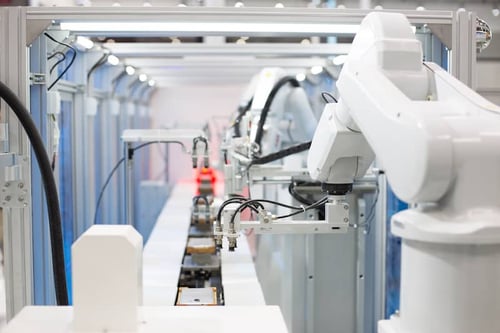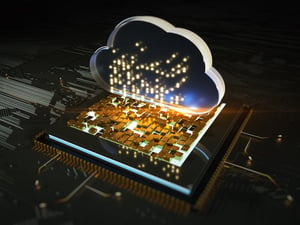Industry 4.0 compared to previous industrial revolutions?

Over the last three centuries, industries have undergone major changes, from manual production to machines and from machines to mass production. After all these transformations, we have now arrived at a system we have reached a point where machines are communicating with each other (machine-to-machine communication or M2M communication), constantly sharing actionable data.
The accelerated pace at which these industrial transformations are being made forces manufacturers to always stay at the forefront of innovation in order to remain competitive. They must not only adapt but, above all, be capable of anticipating the needs of tomorrow. Through advancements in information technology and various computerization methods, Industry 4.0 is completely changing the way commerce is carried out. This natural extension of the last industrial revolution impacts all manufacturing industries, including electronic manufacturing services (EMS) companies.
How does Industry 4.0 transform the way Electronic Manufacturing Services (EMS) providers and contract manufacturing companies operate? Which trends, created by this new industrial revolution, is the world now seeing?`
Industry 4.0 for an EMS Company?
It is important to remember that the First Industrial Revolution, in the 18th century, engendered the development of sectors such as energy and transportation, through steam engines and steamboats. The first factories also made their appearance. The Second Industrial Revolution, in the 19th century, is symbolized by the emergence of electricity, which contributed to the development of many industries (automotive, oil, agriculture, etc.). This was the beginning of mass production. The Third Industrial Revolution began in the 2000s with the development of computers and the Internet. Technology has continued to develop ever since, leading to the Fourth Industrial Revolution, Industry 4.0, the revolution that the world is now experiencing, mostly in the manufacturing services area.
“Cyber-physical systems” are increasingly governing how today’s world functions. Industry 4.0 represents the convergence of physical objects and the virtual and digital world. Creating smart objects tailored to each person’s needs is the goal of Industry 4.0. Today we are surrounded by smart home manufacturing services and smart city manufacturers, without us even realizing it. Smart products and connected devices have recently entered the market. These new, complex products are manufactured by specific contract manufacturers and PCBA companies that have adapted their operations to new methods of working. They have integrated factories capable of mass production of complex and cost-efficient products through investments made into their infrastructures, transforming them into smart factories.
Automation
The basis of operations for smart factories. The automation of electronic manufacturing services and PCB Assembly company processes is critical to maintain competitiveness and improve productions processes, reducing room for mistakes and therefore manage production accurately for anything relating to manufacturing and assembly of electronics products such as consumer electronics, connected devices, green technology products, etc. In addition, the integration of a smart supply chain allows much more complex tasks to be carried out than if they were managed by humans. Thanks to robotics, smart supply chain services, and EMS supply chain management have been completely transformed. This significantly impacts production costs and time.
Artificial intelligence
AI printed circuit board designs and engineering processes bring further flexibility and create a new generation of products, such as connected objects, smart home devices, smart building, IoT devices. Printed Circuit Boards (PCB) for connected devices have been reinvented in order to add the artificial intelligence aspects. Furthermore, EMS companies and smart factories that have their own AI system for supply chain, combining machine learning and big data, are innovating for smart devices.
Cloud computing
The cloud allows you to store all retrieved data, and also to transmit specific instructions, and standardize electronics manufacturing processes and smart supply chain management. Having a cloud strategy in line with your product lifecycle management is a critical aspect of the relationship with an Electronic Manufacturing Services (EMS) company. The relevant tools would help to store the right documentation, allowing production and engineering to make sure the latest revision levels are being used and therefore ensuring that the manufacturing process is robust.
3D-Printing
Because it significantly reduces the manufacturing time for printed circuit board prototypes, 3D-Printing is one of the key aspects of Industry 4.0. This opens more doors for customizing ultra-products: connected devices, Internet-of-Things products, smart home products, etc. PCB Prototyping is now easy to produce.
Internet of Things platforms
Thanks to IoT platforms, data is collected from devices communicating with each other, and users are able to communicate with those devices through the Internet. The Internet of Things connects every machine for instantaneous transmission of information across all departments within the company. This technique offers the opportunity to use or create new business models. When an electronics manufacturing company is able to use these IoT platforms for internal processes, it allows acting and taking decisions rapidly and strictly based on data. It also strengthens the relationship with customers who have access to these data, in full transparency.
Big data analysis & algorithms
Where everything starts. By precisely analyzing users’ behaviors, computer systems are able to draw up precise diagrams to answer and anticipate the needs of each individual. Thus, PCB boards for smart devices are produced with high-end engineering and manufacturing solutions, using big data.
Securing infrastructures
With cyber security becoming essential for all smart supply chain companies, data protection is becoming an integral part of this new industrial revolution. On the other hand, protecting data and product is an essential value for the client’s success. Thus, an intellectual property protection strategy must be part of the electronics manufacturing process.

The key elements for Industry 4.0, therefore, apply both within smart factories and to its products. These technologies allow Electronic Manufacturing Services (EMS) companies to increase manufacturing capabilities, efficiency, and accuracy and be the leader in the mass production of smart devices.
Industry 4.0 will shortly be followed by Industry 5.0. While the previous industrial revolutions extended over a period of decades, the next technological innovations will arrive faster. The digital ecosystem, making its appearance in 2020 and later, will bring together man and machines for a better cooperation. Together, they will improve efficiency and production methods. The revolution will focus to a greater extent on the use of human hands and minds in the industrial process. Through intelligent algorithms, the Internet of Things will become fully developed. This will help to take repeatable tasks out of the picture for collaborators, who will focus on supervising and providing value-add contribution.
It is expected that this duo will take electronic manufacturing services to another level in terms of speed and quality.




